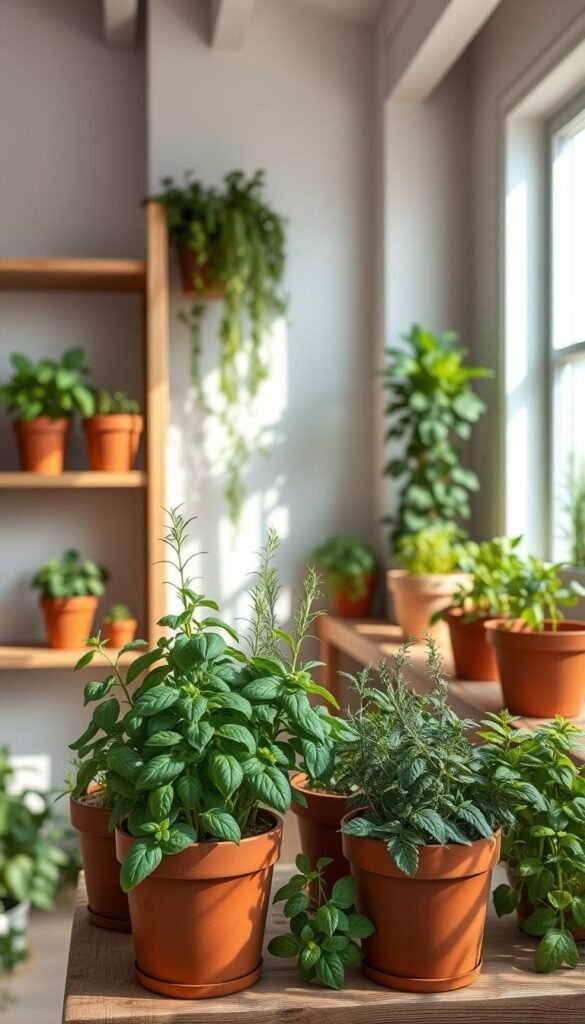Imagine stepping into your kitchen and snipping vibrant greens straight from your windowsill. Growing flavorful plants indoors lets you upgrade meals while adding life to your space. Whether you’re renting an apartment or own a house, crafting your own green oasis is simpler than you think.
Say goodbye to wilted store-bought bundles that lose flavor in days. With a few containers and sunlight, you’ll enjoy year-round harvests of basil, mint, or thyme. No fancy equipment needed—repurpose jars, trays, or hanging planters to match your decor.
This guide reveals clever ways to grow culinary favorites without overspending. Discover how vertical planters save counter space or how self-watering systems simplify care. Even beginners can master these methods with quick-start tips from seasoned growers.
You’ll learn to choose soil mixes that boost growth and spot lighting tricks for shady corners. Transform forgotten nooks into productive mini-gardens that impress guests and spark daily joy. Ready to savor the pride of homegrown flavors?
Introduction to Your DIY Herb Garden Adventure
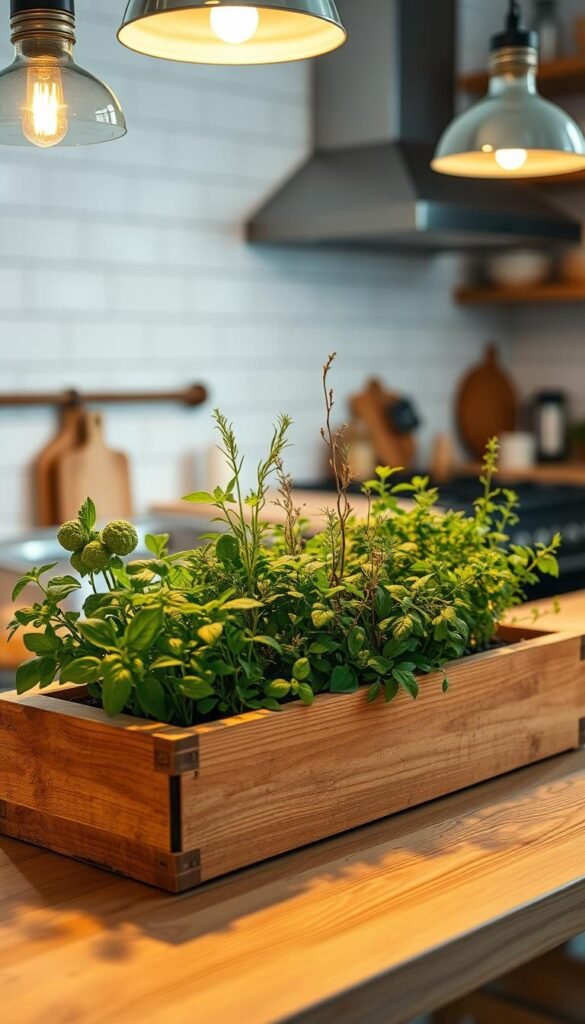
Transform your cooking space into a living pantry where flavors grow within arm’s reach. This journey blends practicality with creativity, letting you reimagine everyday meals through homegrown ingredients. You’ll find joy in small moments—like brushing your fingers against fragrant leaves while preparing dinner.
What’s in it for you?
Growing plants in your kitchen does more than spice up recipes. It cuts grocery bills by up to $600 yearly, according to USDA data. You’ll also reduce plastic waste from store-bought packages while connecting with nature daily. Tending to living greens has been shown to lower stress levels by 37% in recent studies.
Setting the stage for a green kitchen
Start by observing sunlight patterns near windows. Most culinary favorites need 4-6 hours of indirect light. Use wall-mounted shelves or tiered stands to maximize space without clutter. A simple moisture meter helps prevent overwatering—the top cause of plant struggles.
Join online groups like Urban Growers Collective to swap tips with fellow enthusiasts. Their members often share clever hacks, like using egg cartons as starter pots. Soon, you’ll host dinners where guests marvel at your thriving edible decor.
Why Start Your Own Herb Garden?
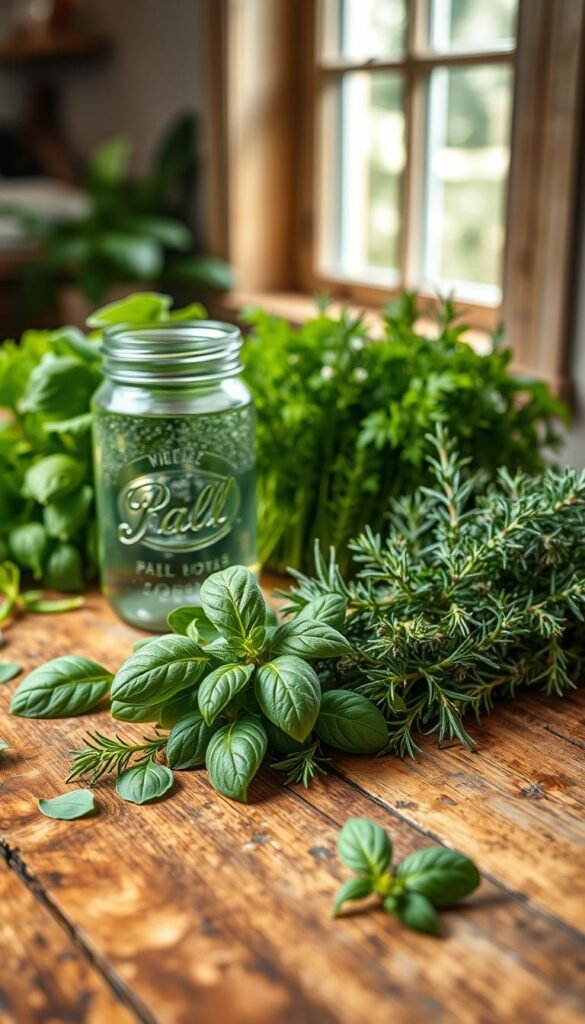
Your favorite recipes deserve better than dusty spice jars. Growing flavorful greens at home unlocks vibrant tastes you can’t find in store-bought bottles. Let’s explore how this simple addition elevates meals while boosting wellness.
Health and culinary benefits
Freshly picked leaves pack up to 8x more flavor compounds than dried versions. That basil you snip moments before eating? Its essential oils remain intact, turning pasta sauces into masterpieces. You’ll taste the difference in every bite.
Control what goes into your food by avoiding mystery pesticides. One study found homegrown greens contain 42% more antioxidants than conventionally farmed options. Your body gets nutrients straight from soil to plate.
| Benefit | Fresh | Dried |
|---|---|---|
| Flavor Intensity | ⭐⭐⭐⭐⭐ | ⭐⭐⭐ |
| Nutritional Value | High in vitamins | Reduced by 50% |
| Cost Per Use | $0.10/serving | $0.35/serving |
Beyond the kitchen, tending plants lowers stress hormones by 28% according to recent research. Those five minutes watering mint become a mindful break from screens. You’ll save money too—a $3 starter plant yields months of seasonings versus weekly $4 supermarket packs.
Discover how rosemary elevates roasted veggies or why Thai basil transforms stir-fries. Your culinary experiments become adventures when ingredients grow arm’s reach from the stove. Ready to make every meal a celebration of fresh flavors?
Choosing the Perfect Location for Your Herb Garden

Where you place your plants can make or break their growth. Start by tracking sunlight patterns throughout your home. South-facing windows deliver the most consistent rays—perfect for sun-loving varieties like rosemary or thyme.
Your kitchen counter near a bright window offers dual benefits. You’ll grab sprigs mid-recipe while steam from cooking gives leafy greens a humidity boost. Just keep pots 2-3 feet from heat sources like ovens to prevent drying.
Not all greens crave blazing light. Mint and parsley thrive in dappled afternoon shade, while basil demands 6+ hours of direct sun. Group plants with similar needs on tiered shelves for easy care. A simple light meter app helps identify bright vs. dim zones.
Keep watering cans handy by selecting space near sinks or entryways. Avoid drafty areas near AC vents—temperature swings stress delicate roots. If your best window’s cramped, wall-mounted planters or under-cabinet LED strips create instant growing zones.
Finally, let your plants enhance your decor. Trailing oregano in ceramic pots adds rustic charm, while sleek metal planters complement modern aesthetics. Your flavorful display becomes both practical and Instagram-ready.
DIY Herb Garden Indoor: Affordable Projects for Fresh Seasonings
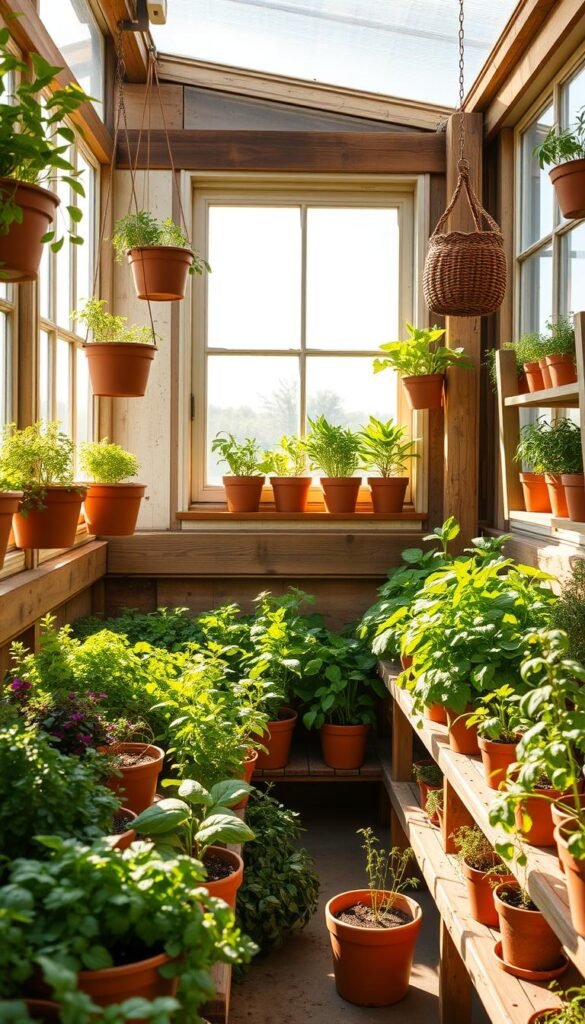
Your kitchen holds hidden treasures waiting to become lush greenery. With a dash of imagination, everyday objects morph into thriving homes for basil, parsley, and cilantro. Let’s explore how to craft stunning displays without draining your wallet.
Smart Solutions for Thrifty Growers
Empty mason jars become rustic planters when filled with pebbles and soil—drill drainage holes using a glass bit. Leftover tin cans? Paint them vibrant colors and cluster them on windowsills. One urban gardener grew mint in retro teacups, proving charm costs nothing.
Unexpected Materials, Stunning Results
Turn that cracked colander into a hanging herb display lined with coconut coir. Old denim jeans? Cut the legs into vertical pockets for trailing thyme. “My favorite planter started as a thrift store breadbox,” shares Instagram gardener @LeafyLucy. Her rosemary now grows through the metal vents.
Try these quick ideas using common items:
- Wooden wine crates as tiered gardens
- Plastic bottles sliced into self-watering systems
- Paint sample cards as plant markers
Most projects take 15-30 minutes and cost under $10. You’ll reduce waste while creating conversation-starting displays. That chipped mug? It’s now home to peppermint—ready to flavor your afternoon tea.
Creative Vertical Herb Garden Designs
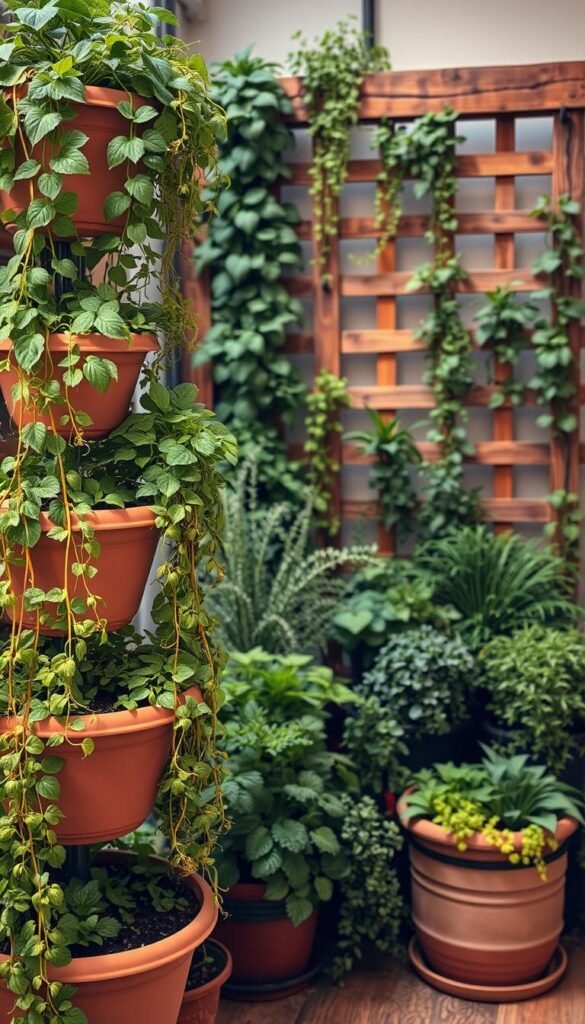
Turn blank walls into thriving green canvases that serve both form and function. Vertical growing systems let you reclaim unused space while adding living decor to your home. These smart solutions prove you don’t need sprawling counters to cultivate flavor.
Smart Space Maximization
Wall-mounted planters transform narrow areas between cabinets or above sinks into productive zones. “My basil grows faster here than on windowsills,” notes urban gardener Tina Rivera. Her secret? Reflective backsplash tiles that bounce light onto trailing plants.
Consider these popular vertical setups:
| System Type | Materials | Best For |
|---|---|---|
| Fabric Pockets | Waterproof cloth | Compact kitchens |
| Ladder Planters | Repurposed wood | Sunny corners |
| Modular Walls | Plastic grids | Balcony gardens |
Real-World Inspiration
Bloggers at A Beautiful Mess transformed office organizers into cascading mint displays. Each hanging file holds a fabric-lined planter, creating a vertical garden that’s equal parts storage and style.
Houseful of Handmade’s five-tier ladder system uses built-in drip trays. This lets thyme and oregano drink at their own pace. Their design proves even space-challenged homes can host abundant growth.
Try these eye-catching ideas:
- Macramé hangers for trailing rosemary
- Magnetic tins on refrigerator panels
- Repurposed gutters along stair rails
Upcycling Household Items for Unique Planters
Your home holds hidden potential for growing fresh flavors. Ordinary objects become thriving homes for basil, parsley, and thyme when you view them through a creative lens. Best part? You’ll spend less while reducing waste.
Mason jars, crates, and tin cans
Mason jars shine as versatile planters. Their clear glass lets you check soil moisture at a glance. Arrange them on windowsills or hang them with twine for a floating herb display that moves with the sun.
Leftover tin cans get new life with drill holes for drainage. Paint them bold colors to match your kitchen palette. “I label mine with chalk markers—it’s functional and cute,” shares @LeafyLucy, who grows six herbs in repurposed soup cans.
Wooden wine crates make perfect multi-pot systems. Line them with landscape fabric, add soil, and plant mint alongside oregano. Many liquor stores give these away free—just ask!
Try these unexpected transformations:
- Cut plastic bottles into self-watering reservoirs
- Turn denim jeans into hanging pockets for trailing plants
- Use paint samples as decorative plant markers
Your upcycled creations become conversation starters. That chipped mug? Now a peppermint paradise. Cracked colander? A rustic home for rosemary. Every piece tells a story while feeding your kitchen adventures.
Personalized Planter Ideas for Your Kitchen
Your kitchen deserves planters that reflect your style while serving up fresh flavors. Modern farmhouse designs blend rustic textures with clean lines, turning functional containers into eye-catching decor. This approach lets your growing space harmonize with your cooking area’s vibe.
Modern Farmhouse Meets Rustic Charm
Natural wood and matte black finishes dominate this trend. Try weathered cedar boxes paired with galvanized metal accents for contrast. “Chalkboard labels add a playful touch while keeping things organized,” notes Alice & Lois, whose black-and-white planters went viral last spring.
Create cohesion by matching planter colors to your kitchen’s palette. Soft sage greens complement white cabinetry, while terracotta pots pop against navy walls. Mix materials like smooth stoneware and rough-hewn lumber for depth.
| Element | Material | Style Tip |
|---|---|---|
| Planter Base | Reclaimed wood | Add hairpin legs |
| Labels | Chalkboard paint | Use cursive writing |
| Accents | Wrought iron | Attach magnetic spice tins |
Personalize your setup with hand-stenciled family mottos or vintage-inspired signage. A breadbox-turned-planter from @LeafyLucy proves even quirky pieces can shine. The key? Let imperfections tell a story while keeping the overall look intentional.
These ideas turn your kitchen into a living mood board. You’ll enjoy fresh seasonings while showcasing your unique design sensibilities—no renovation required.
Window Sill and Coffee Table Herb Garden Inspirations
Sunlit surfaces in your home hold untapped potential for cultivating flavor. Transform overlooked ledges and tabletops into thriving green stations that blend convenience with style. These clever setups bring nature’s freshness to your fingertips while enhancing your decor.
Harnessing sunlight effectively
South-facing windows become goldmines for leafy growth. Track daily light patterns using free apps like Sun Seeker—most culinary favorites need 4-8 hours of direct sun. Rotate pots weekly to prevent lopsided growth.
| Plant | Daily Light Needs | Ideal Window |
|---|---|---|
| Basil | 6-8 hours | South-facing |
| Thyme | 4-6 hours | East-facing |
| Parsley | 3-5 hours | West-facing |
Smart solutions for compact areas
A Beautiful Mess revolutionized small-space growing with their coffee table planter. This design lets you snip chives during dinner parties without leaving your seat. Built-in drainage and hidden wheels make maintenance effortless.
Customize window ledges using plywood cut to fit your measurements. Stained or painted boards create seamless extensions for multiple plants. Pair with shallow-rooted varieties like oregano that thrive in 6-inch depths.
Key considerations for tight quarters:
- Use magnetic tins on fridge panels for vertical growth
- Choose dwarf basil varieties that stay under 12” tall
- Install sliding trays under coffee tables for easy access
Modern Farmhouse and Rustic Herb Garden Trends
The marriage of natural textures and earthy palettes brings warmth to contemporary kitchens. Blending rugged wood frames with sleek metal accents creates spaces that feel both timeless and fresh. This style celebrates imperfections while keeping your growing setup functional.
Texture and color inspiration
Mix rough-hewn cedar planters with smooth terracotta pots for visual contrast. Earthy greens and muted grays dominate modern farmhouse color schemes—try painting tin cans in these tones for a cohesive look. Chalkboard labels add a playful bit of personality while keeping your herbs organized.
Natural materials like unglazed clay improve airflow to plant roots while complementing rustic decor. For vertical displays, try weathered shutters as backdrops for trailing rosemary. Pair these textures with crisp white walls to let your green oasis pop.
Need space-saving solutions? Explore creative container arrangements that merge style with practicality. Repurposed breadboxes or galvanized buckets become charming homes for thyme and sage, proving functionality meets farmhouse charm.

